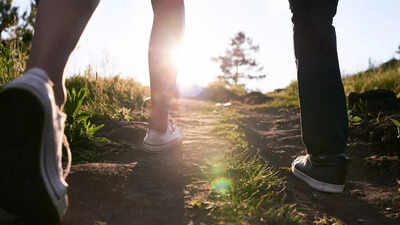While many people brush off walking as basic form of movement, for old people but it’s one of the most effective and underrated ways to stay fit. While it might not help you create the bulky muscle mass you’d expect from heavy lifting at the gym, walking helps develop lean muscle tone.And for many people, that’s exactly the kind of functional strength and definition they’re looking for.It is known that muscle growth begins when the muscle fibers are stressed enough to cause microscopic tears. The body then responds by repairing these tears, reinforcing the area, and gradually increasing strength and tone.
Why is walking important?
While walking doesn’t stress the muscles as intensely as weight training, it does create enough load. Especially when done briskly, over inclines, or for extended periods—to trigger this process in key muscle groups. This is not only great for anyone with a busy lifestyle but also for active individuals looking to complement their gym routines with low-impact muscle engagement. The Centers for Disease Control and Prevention recommends at least 150 minutes of moderate-intensity aerobic activity—such as brisk walking—each week. That’s just 30 minutes a day, five days a week, to begin seeing measurable benefits.So, which muscles actually get stronger and more defined from walking—and how exactly does that happen? Let’s take a closer look.
Glutes

When we walk, our glutes—especially the gluteus maximus—are doing more work than we often realize. As the largest muscle in the body, the gluteus maximus helps extend your hip every time you push your leg backward. It also slows your leg down as your foot hits the ground, helping to control your movement and maintain balance.But it’s not just the big muscles at play. The gluteus medius and minimus, which sit deeper in the hip, have an equally important job. These smaller muscles help pull your leg slightly outward and, more importantly, keep your pelvis stable each time you lift one leg to take a step. Without their support, your hips could dip to one side, disrupting balance and potentially straining your lower back and knees.
Back muscles

It is seen that walking actively engages your back muscles, particularly the erector spinae. This group of muscles runs along both sides of your spine, extending from the base of your skull down to your pelvis. They play a crucial role in helping you stand upright, bend backward, and maintain spinal stability during movement.During walking, the erector spinae muscles work to control the movement of your trunk, ensuring that your spine remains stable as you shift your weight from one leg to the other. This continuous engagement helps in maintaining proper posture and balance.Interestingly, research has shown that individuals with chronic low back pain (CLBP) exhibit higher activation levels of the erector spinae muscles during walking compared to those without back pain. This increased activity is thought to be a compensatory mechanism to stabilize the spine and protect it from further discomfort.
Abdominal muscles

When we think of core muscles, most people picture the visible “six-pack” — but there’s much more to your abdominal muscles than just appearance. This group of muscles stretches from your ribs and sternum all the way down to your pelvis, forming the central support system of your torso.These muscles help with everyday movements like twisting your torso, sitting up from a lying position, and maintaining balance. And much like your back muscles, your abs are constantly at work during walking — especially to stabilize your trunk as you move.Engaging your core while walking (for example, gently pulling your belly button inward) not only improves posture but also makes your walking stride smoother and more efficient. This subtle activation can reduce strain on your lower back and enhance overall balance.Experts often refer to the core as the “powerhouse” of the body, because it plays a central role in nearly all limb movements.


